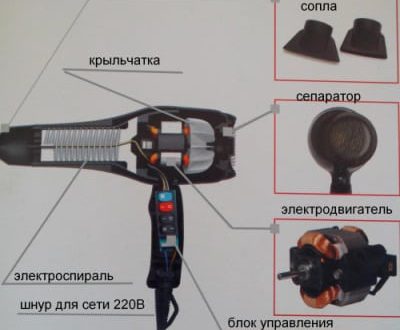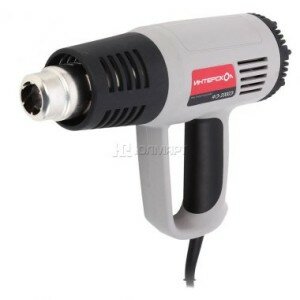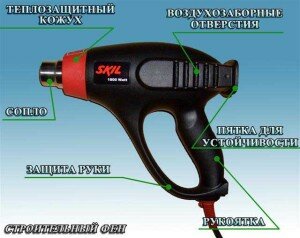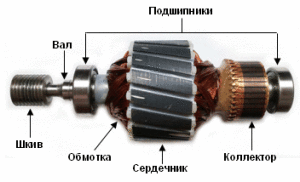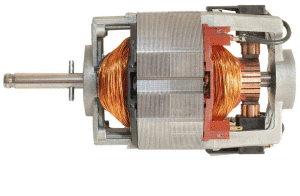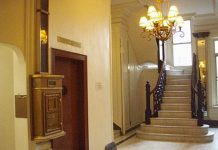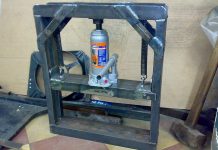In detail: do-it-yourself hair dryer repair from a real master for the site my.housecope.com.
We all are familiar with such an auxiliary tool in construction as a construction electric hair dryer, which we are used to using for removing paint and varnish coatings.
The basic principle of operation of a construction hair dryer is not much different from an ordinary hair dryer that we use to dry our hair.
Accordingly, the electrical circuit of a building hair dryer is similar to the electrical circuit of an ordinary hair dryer.
An explanation will be given in the stated topic:
- electrical diagram of a building hair dryer;
- the principle of the construction hair dryer;
- possible reasons for the malfunction;
- elimination of these malfunctions.
Consider the electrical circuit in Fig. 1 of the building hair dryer:
One diagonal of the diode bridge is connected to an external source of alternating voltage 220V.
The other diagonal of the diode bridge is connected to the electric motor.
The electrical diagram consists of the following elements:
- toggle switch performing the control temperature mode - K1;
- a toggle switch that controls the speed of the blowing speed of the electric motor rotor - K2;
- toggle switch for disconnecting heating elements - K3;
- fan motor - M;
- capacitor - C;
- Heating elements - RTEN;
- diodes - VD1, VD2.
Through the diode bridge circuit of one diagonal of the bridge, the rectified current of two potentials +, - is supplied to the electric motor. When passing from the anode to the cathode, the current flows with a positive half-cycle of the sinusoidal voltage.
Two capacitors connected in parallel in an electric circuit serve as additional smoothing filters.
The blowing speed occurs due to the variability of the resistance in the electrical circuit, that is, when the speed toggle switch is switched to the highest resistance value, the rotation speed of the electric motor rotor decreases due to the voltage drop.
| Video (click to play). |
The number of heating elements of heaters in this scheme is four. The temperature regime of the construction hair dryer is carried out by the temperature control toggle switch.
The heating elements in the electric circuit have different resistance, - accordingly, the heating temperature when switching from one section of the electrical circuit to another - heating the heating elements will correspond to its resistance value.
The general appearance of the construction hair dryer with its names of individual parts is shown in Fig. 2
The following electrical diagram of the building hair dryer in Fig. 3, is comparable to the electrical circuit in Fig. 1
There is no diode bridge in this wiring diagram. Blowing speed control and temperature control - occurs when switching from one section of the electrical circuit to another, namely:
- when switching to a section of an electrical circuit - consisting of a diode;
- when switching to a section of an electrical circuit that does not have a diode.
When a current flows in the anode-cathode junction of the VD1 diode, which has its own resistance, the heating element2 will heat up according to two resistance values:
- resistance at the transition anode - cathode diode VD1;
- resistance of heating element heating element 2.
When a current flows in the anode-cathode junction of the diode VD2, the voltage supplied to the electric motor and the heating element1 will take the lowest value.
Accordingly, the speed of rotation of the rotor of the electric motor and the heating temperature of the heating element for a given section of the electric circuit will correspond to the direct transition of the current of the diode VD2. Heating of the heating element heating element1 for a given section also depends on its internal resistance, that is, the resistance of the heating element is taken into account.
The main reasons for the malfunction of the construction hair dryer here can be called the malfunction of the electronic elements:
Most often, such a malfunction occurs with a sharp jump in an external source of alternating voltage. For example, the cause of a capacitor malfunction is caused by the fact that the capacitor plates are short-circuited when there is a voltage jump among themselves.
Of course, such a possibility of a malfunction as a rupture in the stator winding of an electric motor, winding burnout, is not excluded.
Minor malfunctions include such reasons as:
- oxidation of the temperature control toggle switch contacts;
- oxidation of the contacts of the toggle switch for controlling the blowing speed;
- oxidation of the contacts of the toggle switch for disconnecting the heating elements;
- a wire break in a network cable;
- defective plug lack of contact.
Diagnostics to identify the cause of the malfunction is carried out by the "Multimeter" device.
When replacing a capacitor, its capacity and voltage rating are taken into account.
When replacing a diode, the resistance of two values is taken into account, in the directions:
- from anode to cathode;
- from the cathode to the anode.
As we know, the value of resistance from anode to cathode will be significantly less than from cathode to anode.
With an electric motor, if it malfunctions, things are more complicated. With such a malfunction, it is easier to replace the electric motor than it is permissible to rewind the stator windings. But even such work is doable - who is directly involved in such repairs. In this case, the following is taken into account:
- the number of turns in the stator winding;
- section of copper wire.
Such a malfunction as burnout of the heating element is not excluded. Replacing the heating element is carried out taking into account its resistance value.
Consider the device of electric motors and how exactly it is necessary to diagnose electrical machines, as they are usually considered in the section on electrical engineering.
For an illustrative example, photographs of several types of such electrical machines are presented - related to collector motors. The device and principle of operation are admissible two collector electric motors:
- is no different. The difference in electric motors is only in the rotor speed and in the power of the electric motor. Therefore, we, as it were, will not focus our attention in the sense that explanations are given that are not related to the electric motor of the construction hair dryer.
The electric motor of the building hair dryer is asynchronous, collector, single-phase alternating current.
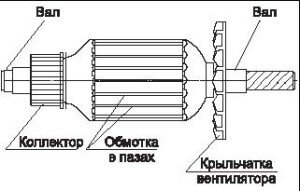
The rotor device does not require any explanation, since everything is shown in the photograph in Fig. 4 and a schematic representation of the electric motor rotor.
asynchronous collector motor single-phase alternating current
The electrical diagram of the collector motor in Fig. 5 is as follows:
In the circuit, we can notice that the collector motor can operate on both alternating and direct current - these are the laws of physics.
The two stator windings of the electric motor are connected in series. Two graphite brushes in contact - in electrical connection with the motor rotor collector.
The electrical circuit closes on the rotor windings, - accordingly, the rotor windings in the electrical circuit are connected in parallel through the brush-collector sliding contact.
diagnostics of stator windings of an electric motor
The photograph shows one of the methods for diagnosing the stator windings of an electric motor. In this way, the integrity or insulation breakdown of the stator windings is checked. That is, one probe of the device is connected to any of the removed ends of the stator windings, the other probe of the device is connected to the stator core.
In the event that the insulation of the stator winding is broken and the winding wiring shorts to the core, the device will indicate a zero resistance value in the short circuit mode. It follows from this that the stator winding is defective.
The device in the photograph indicates a one when diagnosing - this does not mean that this stator winding is suitable for operation.
It is also necessary to measure the resistance of the windings themselves. Diagnostics is carried out in the same way, - the probes of the device are connected to the removed ends of the wires of the stator windings. With the integrity of the windings, the display of the device will indicate the resistance value possessed by this or that winding. If one or another stator winding breaks, the device will show "one". If the stator winding wires are short-circuited with each other as a result of overheating of the electric motor or for other other reasons, the device will indicate the lowest zero resistance value or "short circuit mode".
How to check the resistance of the rotor winding with a device? - To do this, you need to connect two test leads of the device to two opposite sides of the collector, that is, you need to make the same connection that graphite brushes have in electrical connection with the collector. The diagnostic results are reduced to the same indications as when diagnosing the stator windings.
What is a collector in general? - The collector is a hollow cylinder consisting of small copper plates of a special alloy, isolated from each other and from the rotor shaft.
In the event that the damage to the collector plates is insignificant, the collector plates are cleaned with fine-grained emery paper. Again, this amount of work can be performed directly only by specialists who repair electric motors.
The electrical circuit in Fig. 7 consists of a battery and a light bulb, this circuit is comparable to that of a pocket flashlight. One end of the negative potential wire is connected to the stator core, the other end of the positive potential wire connects to one of the brought out ends of the stator windings. If the wires are connected the other way around, that is, "plus" to the stator core, "minus" to the withdrawn end of the stator winding, nothing changes from this.
In the presence of insulation breakdown, when the stator winding is closed with the core, the light in this electrical circuit will be on. Accordingly, if the light does not light up, then the stator winding is not closed with the stator core.
This method of diagnosing Fig. 7 is not complete. Accurate diagnostics is carried out only with an Ohmmeter device or a Multimeter device with a set resistance measurement range, for subsequent measurement of the resistance of the stator windings.
A hair dryer consists of a motor, a fan, heating elements, an electrical circuit that makes the elements work in concert. Depending on the number of modes, the manufacturer, the element base, appearance, and the composition of the switches are different. But nothing more complicated than a semiconductor thyristor will not be inside. Therefore, we will carry out home repair of hair dryers with our own hands.
The body is held in place by screws. The heads are often of a non-standard design. This is a plus sign, an asterisk, a pitchfork. Therefore, first of all, before fixing the hair dryer, let's take care of a tool that can cope with such a task. Fortunately, a set of bits costs 600 rubles today.
Sometimes the case flaps are additionally fastened together with special latches. This is a separate problem: experienced craftsmen often break plastic, desperate to cope with civilized methods. There are no subtleties, they come up with hidden screws hidden under stickers, plastic inserts, removable regulator caps. The fasteners are fictitious. There are no useful functions.
The hair dryer motor is powered by direct current 12, 24, 36 V. To rectify the mains voltage, a diode bridge is used, in cheap models - a single diode. The filtering of power harmonics is carried out by a capacitor connected in parallel to the motor windings or as part of a more complex filter. Inductors are rarely used in hair dryers due to their exorbitant mass.Therefore, knowledge of the principles of smoothing pulsations with RC-chains is enough to cope with the construction of a schematic diagram of a hair dryer being repaired. Sometimes a single coil (inductance) is used by the filter element.
The hair dryer switch simultaneously closes the circuit through which the spirals will be powered, starts the motor. Further schematic of the intervention is determined by the complexity:
- only the rotation speed or only the temperature is regulated;
- the ability to select heating and air flow rate separately.
In most models of hair dryers, in parallel, there is protection against turning on the heaters when the motor is inactive. Protects the spiral.
Optionally available thermostat in the form of a special resistance or other sensitive element. Let's describe the breakdowns encountered by the faithful helpers of the beautiful half of humanity.
If the device is devoid of signs of life, it is unstable, the inspection begins with the power circuit. The repair of Rowenta hair dryers is schematically described below.
Attention! The described types of work require skills in handling electrical appliances. The authors disclaim responsibility for damage to health, property, arising from attempts to follow the recommendations given for repairing hair dryers.
Inspection of the power cord begins with a socket. There is a part of the malfunction: there is no voltage - the hair dryer does not work. If there is voltage in the outlet, the inspection of the cord begins with the entry point into the case, walk towards the plug. Work is performed on a de-energized device. A visual search for fractures and irregular formations - burners, insulation damage, fractures is carried out.
Then the case of the hair dryer is disassembled. Inside you have a chance to see the options for electrical resistance:
- A pair of detachable contacts.
- Soldering.
- The wiring is sealed in plastic caps.
The last element of the list characterizes a non-separable connection, therefore, the case for testing is too complicated. Skillful hands, or rather, smart heads, Ukrainian brothers in mind are advised to use an ordinary needle to repair a hair dryer. Those who immediately grasp the train of thought will skip the next paragraph, start testing directly.
Do-it-yourself hair dryer repair begins with a continuity of the wiring. A Chinese tester, a light bulb, an indicator will do. A needle is attached to one terminal, which is then inserted into the power core in the area of the cap through the insulation to copper. The second terminal probes the legs of the plug. The call goes through for both cores. It is not worth doing more than 1 puncture per core when repairing a hair dryer (some will try to look for a breakage as well), since the nature of the operation involves the ingress of moisture from wet hair.
Even a child can ring the wire, having visually distinguishable docking points in front of his eyes. If damage is found, it is recommended to buy a new cord fitted with a non-separable plug. The likelihood of moisture ingress imposes restrictions on the choice of insulation of conductive parts used to repair a hair dryer.
Cases are common: the first glance reveals the place of damage to the cord entrance into the case. Slabs, carbon deposits, black insulation indicate the location of the fault.
At the junction with the body of the hair dryer, there is a vulnerable point of the wiring. The hostess takes the delicate device by the cord, shakes it from side to side, winds the cable around the handle. A vein with a crack sparks, the insulation heats up, burns out, the copper melts. This is the mechanism of damage to copper conductors.
When updating, it is useful to short-circuit the switch, check: the hair dryer will change the behavior radically in response to an uncomplicated step. There are three-position switches, each position in a short-circuited state is checked separately. Remember, sketch out the original wire layout before you start fixing the hair dryer.
Checking the speed, temperature switches uses a similar circuit.
Examine the defective element identified during the restoration of the hair dryer. The carbon deposits are cleaned off with a file, sandpaper, eraser. The contacts are wiped with alcohol.Defective components are replaced with equivalents. A radical method is to short-circuit the power button while searching for suitable components.
Relatively often, the air duct is clogged with a hair dryer. It is necessary to remove the filter, if any, and clean it thoroughly. Remove dust from crevices with a soft brush.
Lack of blade rotation or low rpm is often observed when the hair is coiled around the motor shaft. The propeller must be carefully removed from the shaft, in every possible way avoiding unnecessary efforts and distortions. After that, foreign objects are removed.
A hair dryer usually has several heating elements. Visually, they should all look uniform. Make sure of this when fixing the hair dryer by opening the case. The detected breaks are eliminated by twisting the ends, soldering and tinning. You can also get some thin copper tubes and squeeze the ends of the broken spiral inward.
We observe defects in heating elements during repairs visually. A close inspection will tell you how to fix your hair dryer. Replacing spirals with similar purchased or homemade products made of nichrome wire is effective.
The electric motor of the hair dryer can be powered by both direct current and alternating current. If the diode bridge is burned out, the windings are damaged, normal functioning is impaired. A terrible crackle and sparks when turned on indicate a malfunction of the motor.
The motor windings are desoldered when repairing the hair dryer from the electrical circuit. Find a pair for each wire that rings. The conclusions are connected in threes, none should hang in the air. Replacement of the winding when repairing a hair dryer is carried out only in a workshop. However, folk craftsmen shake not worse than machine tools. Those who wish will try.
If the windings are in good working order, the brushes are examined, the copper surface under them is cleaned, and the tightness is estimated.
The axis should rotate freely. When repairing a hair dryer, it will not hurt to lubricate the rubbing surfaces, manually break in problem areas.
The getinax backing sometimes cracks, tearing the track. Tin the damaged area, lightly cover with solder.
Broken capacitors swell slightly. The top face of the cylinder contains shallow slots, when the product breaks, the sidewall inflates, bending outward. Replace such a capacitor first if you find a characteristic defect.
Burnt-out resistors darken. Some remain operational, it is advisable to replace such a radio element.
Some hair dryers are self-regulating. The effect is achieved by using a resistive divider, one arm of which is an element that responds to temperature. Further actions are determined by the parameter control implementation scheme. We recommend:
- eliminate the sensor altogether by breaking the circuit, try the device's reaction;
- short-circuit the wires after that, turn on, see what happens.
There is a great chance of failure if the device is trained to respond only to a fixed resistance value. It remains to look for a schematic diagram on the Internet or draw it yourself.
Repairing professional hair dryers is more difficult. Structural elements are often complemented by smooth controls and additional options such as the Care button. The spirals are made of special alloys that create negative ions when heated, which have a beneficial effect on the hair. The technique remains the same:
- cord;
- switches and buttons;
- dust removal;
- spirals;
- motor;
- visual inspection of capacitors, resistors.
Before repairing it, it is advisable to get a schematic diagram.
Industrial models are not much different from household ones. But drying your hair is not recommended. Such products are distinguished by their increased resistance to dust, shock, vibration, humidity, and other climatic factors. Home restoration of industrial hair dryers will not end well.
Electric radio products used in household models are not suitable for use in harsh environments.Requirements apply to wires, power cord, motor and coils.
With the help of a hair dryer, you can heat up old varnish or paint to remove them from the surface. During construction, it is used to solder metal, as well as to facilitate the handling of plastic pipes. In a heated state, they lend themselves well to bending. This tool is very whimsical, and in case of improper use it will have to be repaired, and this is not an easy task.
Consider how to repair a building hair dryer with your own hands. A person can always contact specialized service centers for such a service, but this is not always advisable. In some cases, breakdowns can be diagnosed independently, respectively, and the repair of the construction hair dryer itself can be done. Before that, it is imperative to get acquainted with the device device. This is where the instruction should begin.
Opening the device reveals a small motor, heating element and fan. The heated air exits through the nozzle. Everything is simple enough. Basically, the structure does not differ from an ordinary hair dryer. The only difference is the higher power of the device. The performance of the equipment directly depends on how many liters of air it can pass through itself in 1 minute. Many hair dryer models on the market today have a number of additional functions. These include:
Using a building hair dryer.
- temperature control;
- air flow regulation;
- selection of the required operating mode;
- numerous additional attachments that will significantly simplify the work with this or that material;
- LED indicator that determines the heating temperature.
Of course, these are not all the options that a building hair dryer can have. There are others. You should always remember that the more there are, the more difficult it is to make repairs.
Breakage of such a tool can occur at any time during its operation. It is especially unpleasant if this is in the midst of construction work. In most cases, the person himself is to blame, who is often negligent about the power tool. The main breakdowns are considered to be the bend of the power cord, a malfunction of the button for turning on the tool and adjusting the temperature. Of course, more global breakdowns can also occur.
Wiring diagram for a hair dryer.
For example, a motor or fan may be damaged. The heating element is not eternal in this respect. Most of the faults can be diagnosed on their own, but there are those that have to be identified for a long time. In this situation, it is best to contact a specialized service center.
If a person is confident in his abilities, then he can repair the hair dryer on his own.
The most difficult breakdowns include engine or fan breakdown. In most cases they need to be replaced and it is difficult to find the right spare parts.
Before proceeding with repair work, it is imperative to inspect the device.
Already at this moment, most of the troubles can be identified. Be sure to pay attention to the on and off buttons of the tool, as well as the state of the wiring. Perhaps the cord was just broken in some place or the plug was broken. All this can be determined already at the preliminary stage of work.

